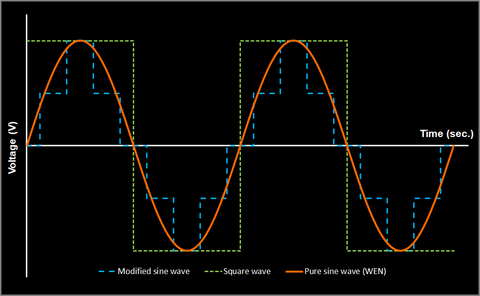Shop Here
Shop Here

Total harmonic distortion: if you're in the market for a new generator or portable power station, or if you're a disgruntled and overtired electrical engineering student, you may be familiar with the term. If not, you would be forgiven for thinking it's the name of a cartoonishly pseudoscientific superweapon effect, or a truly terrible band name. Despite sounding rather intimidating, it's actually a relatively simple concept - one that you need to know, whether you want to make an informed purchase or just pass your upcoming midterm.
Total harmonic distortion (THD from here on out) is an important concept in signal, electrical, and electronics engineering, and is measured in percent (%). It's the total amount of distortion in an electrical signal caused by the presence of harmonics within that signal. Without getting too technical, harmonics are multiples (2x, 3x, 4x, etc.) of the signal's fundamental frequency - the lowest frequency of a repeating waveform.
Let's take a concrete example. The power that comes out of the wall sockets in your house is AC (alternating current) power. You may also have heard of DC (direct current) power. The difference is that AC power changes (alternates) over time, whereas DC power stays basically the same. An example of an AC (orange) and a DC (blue) signal is shown below.

AC (orange) vs. DC (blue) power. The AC signal shown here is in the shape of a sine wave. More on that later.
The AC power in your house is set to a standard frequency, which is a measure of how often the signal repeats, as well as a standard voltage. In the US, AC power is standardized at 120 volts, repeating 60 times per second (60 Hertz, abbreviated Hz).
Still with me so far? Good. This is where harmonics come in. In your home's power, if you measured and graphed it, that 60Hz signal wouldn't be totally perfect. It would have some slight distortion in it. That distortion comes partially from harmonics, which in this case, would be components of the signal at 120Hz, 180Hz, 240Hz, etc. - all multiples (2x, 3x, 4x, like we mentioned earlier) of the fundamental frequency, which in this case is 60Hz. If you were to do some math on the measurements you take (which is too complicated to dive into here), you would be able to calculate the THD.
Depending on where and how your power is produced, the load on the power grid, temperature, the age of your home's wiring, and many other factors, the THD in your home's power may vary. Usually, it's about 2% to 3% on any given day for most municipal locations.
Good question. The higher the THD, the "dirtier" the power. The presence of those extra harmonics can cause some unintended side effects, including excessive heating and excessive radio interference, and some sensitive electronic devices (such as smart devices, computers, TVs, etc.) may not work properly or at all, since they tend to expect "clean" (low-THD) power, such as what you get from your wall outlets.
So what does this mean for you, dear reader? It means that if you're looking for a generator or power station, you need to know a few things:
Our helpful articles on how to choose a generator, how inverter generators work, and advantages of inverter generators may be handy resources. If you have any sensitive electronics that you need to power, you should strongly consider an inverter generator, or a high-quality portable power station, since they tend to produce low-THD power. Look for the phrase "sine wave" or "pure sine wave" in the specifications list.
Generators are usually less expensive per watt than portable power stations, and are often capable of producing more power overall. However, this comes with added weight, maintenance, noise, and emissions requirements. If you're looking for a small power source to take camping, or just something to keep your phones and tablets charged during a brief power outage, a power station may be the way to go. If you need more power, or don't want to spend as much money per watt, a generator is probably the better bet.
Generally, traditional generators produce AC power with a THD between 5% and 20%, depending on the amount and type of load applied. WEN inverter generators and portable power stations produce very-low-THD AC power, usually under 1.5%, since they use pure-sine-wave inverters, which are devices that (as the name implies) create AC power whose signals are pure sine waves. Other generators or power stations may use inverters that create square wave or modified sine wave power; a diagram of all three types of power is below. Pure-sine-wave power is ideal. Square-wave or modified-sine-wave power may damage sensitive devices or contribute to a shorter lifespan, since they have much higher THD values - a square wave's THD is about 48 percent!

A comparison of pure-sine-wave (orange), modified-sine-wave (blue), and square-wave (green) AC power. All WEN inverter generators and portable power stations produce pure-sine-wave AC power, often at a higher quality than what you get from the grid.
Thanks for reading! We hope this has been a helpful resource in understanding generator power a little better. If you have any questions about which WEN generator is right for you, or need more information, please give us a call at 1-847-429-9263 (M – F, 8 – 5 CST), or drop us a message here to talk to our friendly and knowledgeable technical support team.
Leave a comment